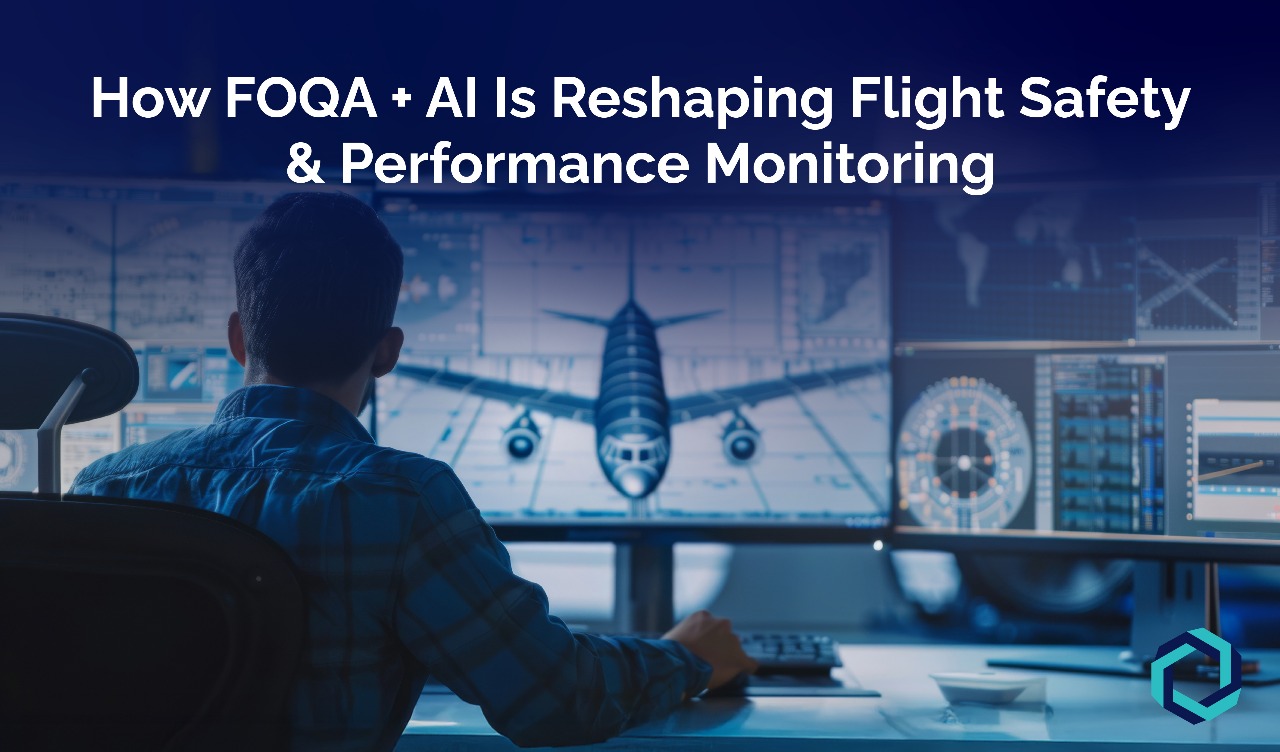
Introduction: The Next Evolution in Flight Data Analysis
In today’s data-driven aviation landscape, Flight Operations Quality Assurance (FOQA) has become the cornerstone of proactive flight safety management. But as aircraft generate terabytes of real-time data, traditional FOQA analysis methods struggle to keep up.
Enter Artificial Intelligence (AI) the game-changer redefining how airlines, MROs, and OEMs interpret, act, and predict flight safety insights. The integration of FOQA + AI is unlocking predictive intelligence, automated anomaly detection, and performance optimization that were once impossible.
What Is FOQA and Why It Matters
To put it simply, Flight Operations Quality Assurance (FOQA), also known as Flight Data Monitoring (FDM), involves the systematic collection and analysis of flight data from aircraft to enhance safety and operational efficiency.
By monitoring hundreds of flight parameters—speed, altitude, engine health, pilot inputs—FOQA programs help operators:
- Identify unsafe trends before they lead to incidents
- Reduce maintenance costs through proactive detection
- Enhance fuel efficiency and route performance
However, traditional FOQA systems rely heavily on manual analysis and rule-based logic, limiting scalability and responsiveness. That’s where AI-powered FOQA systems are reshaping the skies.

How AI Is Powering the Next-Gen FOQA Revolution
The fusion of FOQA + AI introduces intelligent automation and predictive analytics into flight safety monitoring. Here’s how AI transforms FOQA systems:
1. Predictive Anomaly Detection
AI models continuously learn from flight data to detect subtle deviations that might indicate early signs of mechanical failure or pilot deviation. Example: Machine Learning (ML) models can flag unusual pitch or thrust behavior long before traditional systems would.
2. Automated Event Classification
AI algorithms can automatically classify flight events—like unstable approaches or excessive descent rates—without manual data sorting, saving hundreds of analyst hours.
3.Performance Optimization
AI AI-driven FOQA tools analyze trends across fleets to optimize:
- Fuel consumption patterns
- Climb and descent profiles
- Flight path deviations
- Engine performance baselines
4. Real-Time Flight Risk Scoring
Edge AI embedded in aircraft systems provides instant feedback to flight crews and ground control, enabling proactive decision-making during flight.
5. Maintenance Prediction
When integrated with Aircraft Health Monitoring (AHM) and Predictive Maintenance Systems, AI-based FOQA can forecast potential component wear—reducing unscheduled AOG events and boosting fleet uptime.
The Role of Deep Learning in Flight Data Analytics
Deep Learning models such as Recurrent Neural Networks (RNNs) and Convolutional Neural Networks (CNNs) can process time-series flight data to uncover non-linear correlations between flight variables.
- Detect hidden safety risks
- Model fuel efficiency variations
- Understand flight behavior in different weather or load conditions
- Create digital twins for aircraft performance simulation
This allows airlines to:
With AI + FOQA integration, operators gain a data ecosystem capable of continuous learning and optimization.
Real-World Impact: From Safety to Sustainability
The transformation isn’t theoretical — leading airlines and aerospace innovators are already leveraging AI-driven FOQA platforms for:
- 40% faster safety event detection
- 25% reduction in fuel inefficiency
- Up to 30% lower maintenance costs
This allows airlines to:
Furthermore, AI-powered insights contribute to sustainability goals by minimizing fuel burn, optimizing routes, and reducing carbon emissions.
FOQA + AI Integration with ProHM+ (Example Use Case)
Consider ProHM+, an AI-driven aircraft intelligence platform that seamlessly integrates FOQA, Aircraft Performance Monitoring (APM), and Fuel Analytics.
By combining flight data, engine telemetry, and operational metrics, it enables:
- End-to-end flight risk prediction
- Actionable dashboards for operations managers
- Cross-fleet performance benchmarking
This allows airlines to:
Such systems mark the shift from reactive safety management to predictive aviation intelligence.
The Future of FOQA + AI in Aviation Safety
As the aviation industry embraces digital transformation, AI-enhanced FOQA systems will evolve into self-learning safety ecosystems, capable of:
- Autonomous anomaly detection.
- Continuous data fusion from IoT and Edge AI sources.
- Integration with ATC, weather, and maintenance systems.
- Real-time recommendations to cockpit and ground ops.
The future of flight safety lies in AI-driven predictive intelligence, not post-flight analysis.
Conclusion: From Data Collection to Data Intelligence
The convergence of FOQA and AI represents a monumental leap for aviation safety, reliability, and efficiency.
It shifts the paradigm from monitoring what went wrong to predicting what could go wrong ensuring safer, smarter, and more sustainable skies.

Want to Know More? Schedule a Demo Call.